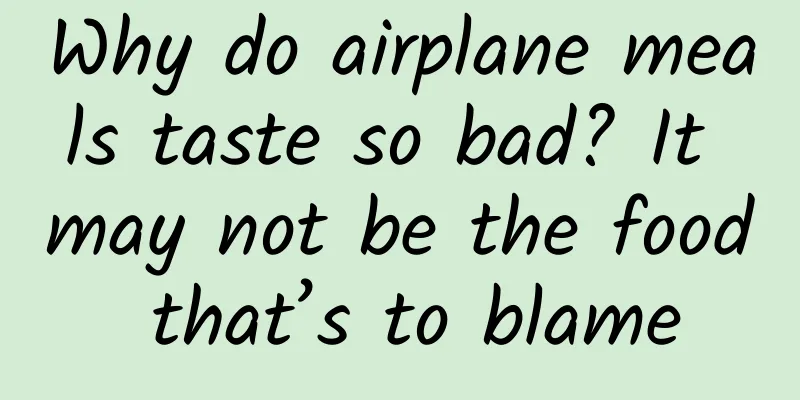Why do airplane meals taste so bad? It may not be the food that’s to blame

|
When you are on an airplane, you may have had this feeling: airplane food always tastes bland. In fact, the bad taste of in-flight food is not entirely a problem with the food itself. What is the difference between eating the same meal on the ground and eating it in the cabin at high altitude? In 2010, Lufthansa found that passengers consumed much more tomato juice on the plane than on the ground. Why did ordinary tomato juice become a favorite in the cabin after it went to the sky? In order to find the answer, Lufthansa hired a well-known German research institute to conduct an experiment. The researchers took a group of people into an airplane simulation cabin on the ground to simulate the high-altitude environment, cabin pressure, engine noise, and even the blue sky and white clouds outside the window. As a result, the participants unanimously agreed that the tomato juice in the simulation cabin tasted better. Seeing this, I believe you must have noticed that the high-altitude flight environment is the biggest factor affecting our ability to perceive smells. It turns out that when the plane enters a level flight state, the air pressure at high altitudes will be significantly lower than the standard atmospheric pressure. Although the cabin will be pressurized, it still cannot reach the same state as the ground. And without the "seasoning" of humidity, the "insensitivity" of our senses will be significantly enhanced. At an altitude of about 30,000 feet, the humidity in the cabin is less than 12%, which is drier than most deserts. Such an environment will affect the secretion of nasal mucus. When the nasal cavity is very dry, the brain's efficiency in detecting odor signals will be reduced, thereby affecting our sense of smell. In addition to not being able to smell the aroma of food, the cabin environment may also make passengers unable to taste the original flavor of food. Studies have shown that when eating in a low-pressure, dry cabin, people's perception of salt will decrease by 20% to 30%, and their perception of sugar will decrease by 15% to 20%. You should know that people's perception of taste is not only based on taste, but also affected by smell, touch, vision and hearing. Although the tongue can only taste 5 flavors, the sense of smell can distinguish hundreds of gas molecules, so the smell of food will bring rich sensory changes. For example, when people have a cold, they always feel that the food they eat has no taste, because their sense of smell is weakened. The temperature and touch of food also constitute part of the taste. The food in the mouth activates the sensory cells in the mouth, so we can perceive that cream cakes and crispy potato chips have different tastes. In addition, people generally think that desserts on white plates are sweeter than those on black plates, and eating potato chips with your mouth open is crisper than eating them with your mouth closed, which shows that vision and hearing also play an indispensable role in the perception of taste. Noise on the plane can also affect passengers' perception of sweetness. Kimberly Young and Robin Dando, researchers at the Department of Food Science at Cornell University in the United States, have studied the impact of noise on five basic tastes. The test results found that noise does not affect the testers' judgment of the three tastes of saltiness, bitterness and sourness. But if the cabin noise exceeds 85 decibels, people's perception of sweetness will weaken and their perception of umami will increase. Therefore, strong-flavored drinks such as tomato juice will become more delicious than usual. In addition to the cabin environment, the facilities on the plane will also affect the taste of the food. Food safety is always the primary consideration for airlines. When cooking on the ground, the selection of ingredients can be "unrestrained", but the selection of ingredients for airplane meals must be cautious. According to the hygiene standards for aviation food, high-protein, high-carbohydrate, and easily perishable ingredients have potential safety risks, so soy products and fried foods rarely appear on airplane menus. In addition to being fresh, the ingredients purchased for airplane meals must also pay attention to appearance and detect pesticide residues in fruits and vegetables. For example, cucumbers should be selected straight to ensure that each meal is equal when cut. Foods with bones, thorns, and pungent tastes are almost not considered, because if there is turbulence during the flight, such food can easily cause passengers to choke. At the same time, passengers on the same flight may be vegetarians, people who are allergic to certain foods, people who don't like spicy food, people with lactose intolerance, pregnant women, people with poor immune systems... Different dietary preferences and restrictions require airlines to satisfy the tastes of more passengers while ensuring food safety. In addition, airplane meals are generally refrigerated, dried, and sealed for preservation, and are reheated before being served to passengers. This different processing method from ground meals will also affect the taste of the food to a certain extent. Although the taste of airplane meals is affected by many factors, major airlines have been working hard to improve the quality of meals in order to meet passengers' demand for food. On the basis of ensuring food safety, many airline chefs continue to study dishes and continuously update the in-flight menu to provide passengers with more choices. In addition, most airlines have launched personalized services for passengers with special needs, such as children's meals, religious meals, vegetarian meals, medical meals and other special meals, which passengers can book in advance. After learning about the "little-known facts" about airplane meals, you may understand the challenges of making airplane meals and better understand the good intentions of airlines. Next time you fly, you may want to try some "hidden" possibilities under the limited cabin conditions and choose food with stronger umami flavor to maximize the pleasure brought by the in-flight food. |
<<: I drafted a book for my supervisor, but unexpectedly got a doctoral dissertation...
>>: 8D Magic Chongqing: Our reputation as the “City of Bridges” is well deserved!
Recommend
Hisense Launches Global Brilliance Plan and Releases New Overseas ULED TVs
On June 7, the Asian CES exhibition, which fully ...
Operation and promotion: How to use the AARRR model to attract 150,000 fans in 10 days at 0 cost?
I believe that many people engaged in operations ...
Android 5.0's most beneficial and most useless new feature
There are so many new changes in Android 5.0 Loll...
Damage to the liver, change genes? Do you still dare to "eat rainbow"?
Snacks are really a magical thing. From children ...
Live broadcast operation plan sop
What is the effect of online live streaming on cu...
After 6 years, the first perfect jailbreak of iOS 14 is released: supports iPhone 12
[[431010]] Since the perfect jailbreak in the iOS...
Swallowing gold, detoxifying, mining, I'm talking about microorganisms
Produced by: Science Popularization China Produce...
I have acne breakouts. Can I use the “Internet celebrity” ointment recommended by beauty bloggers?
Spring is here, A heart that loves beauty is eage...
Pure dry goods: "QQ space talk like" traffic-generating skills, attracting 50 precise fans a day is not a problem!
Hello everyone, I am Island Master Huang. Yesterd...
How to quickly build a knowledge system for topic event planning?
Many event operators will painfully discover afte...
Today in Science and Technology History | 1609·8·21 The first astronomical telescope was born
Since ancient times, human beings have never stop...
13 tips for making popular notes on Xiaohongshu!
In January 2019, the number of Xiaohongshu users ...
Can picking your ears actually cause tumors? You should learn these two points as soon as possible
Have you ever noticed that some people often pick...
The game of advertising space allocation in search bidding promotion
People in the industry all know something about t...









